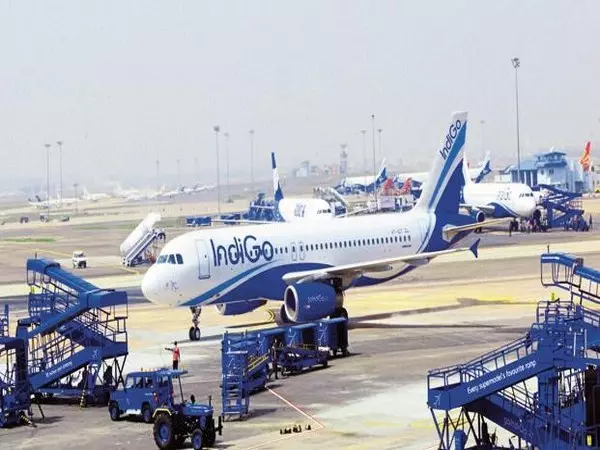
IndiGo's stellar ascent may lead airline to command two-thirds of the skies
Yet, it’s not all clear blue skies for IndiGo; the recent quarter did see challenges, most notably from the escalation in engine issues at Pratt & Whitney

While the rest of the domestic airlines are barely able to stay afloat, IndiGo’s stellar performance during the first quarter of the current fiscal shows that it has galloped way beyond the reach of any competition and might be a handshake away from owning two-thirds of the market.
Yet, it’s not all blue skies for IndiGo. The recent quarter did see challenges, most notably from the escalation in engine issues at Pratt & Whitney. While the engine recalls and subsequent groundings threw a spanner in the works, especially when the airline was aggressively looking to expand its fleet and serve more customers.
Although the airline, with a current market share of 61.4 per cent, is transitioning to CFM engines, which offer comparable fuel efficiency, the transition and the associated challenges are something to watch out for. Furthermore, despite the record quarter, there is a palpable pressure on yields, a key airline revenue metric. This, coupled with the increase in Aviation Turbine Fuel (ATF) prices by around 11 per cent in the past two months, raises concerns.
While not unique to IndiGo, these industry dynamics necessitate nimble strategy adjustments.
IndiGo's robust performance
First, the numbers: IndiGo posted a net profit of ₹3,090 crore for the first quarter of the current financial year, compared with a loss of ₹1,064.3 crore for the same period last year. The net revenue from operations because of high ticket prices and weak competition rose 29.7 per cent to ₹16,683 crore. The total revenue grew 31.8 per cent to ₹17,160.09 crore for the same period.
Looking at the data more closely, one can see a decisive load factor of 88.7 per cent and a commendable yield of ₹5.1. These numbers are not just happenstance. They reflect a concerted effort by the airline’s management to leverage favourable market conditions like the drop in crude prices, resulting in a 26.6 per cent YoY decline in fuel Cost per Available Seat Kilometre (CASK) to Rs 1.6.
It must be admitted that the journey of IndiGo over the years, from a newbie in the industry to its current dominance in the Indian skies, has been underpinned by its continuous focus on expanding its capacity and network. For FY24E, despite specific challenges with the P&W engines, the airline’s capacity guidance remains unchanged, underlining its resilience. The plan for network expansion in both domestic and international markets is set to bolster its position even further.
IndiGo’s superior balance sheet, marked by a staggering ₹15,691 crore of free cash, gives it a formidable war chest. This liquidity cushions the airline against industry headwinds and provides it with the arsenal to explore new avenues. The airline’s foray into venture capital focusing on aviation, travel, and hospitality underscores its vision to seed future growth drivers. Though modest, an initial capital commitment of ₹7 crore for this venture indicates the airline’s intent to diversify its investments and gain early entry into innovative startups that could redefine aviation and allied sectors.
IndiGo’s planned expansion to new destinations in the US, Asia, and Africa, and its strategic partnerships, like the codeshare agreement with Turkish Airlines, give it a firm footing in the international arena. With a robust order book and a clear vision to enhance its network, IndiGo is geared up for the next growth phase.
Areas of concern
However, amidst this rosy picture, there are areas of concern. Sequentially, yields are experiencing more significant pressure than in the past. Aviation Turbine Fuel (ATF) prices have surged by approximately 11 per cent in the last two months, leading to a revision of EBITDAR estimates downwards by around 7 per cent for FY24 and FY25E. In addition, engine challenges from Pratt & Whitney have added a layer of unpredictability.
While the short-term impact is limited, with grounded planes remaining in the single digits, the long-term repercussions remain.
Outlook for IndiGo
Despite these potential setbacks, the outlook for IndiGo remains optimistic. The airline’s goal to serve 100 million passengers in FY24E, supported by an outstanding order book of around 1,000 aircraft, demonstrates its ambition. Incorporating CFM engines in their new aircraft fleet, believed to have similar fuel efficiency to the P&W engines, will likely eliminate potential engine-related disruptions in the future.
IndiGo’s recent performance goes beyond mere numbers. A record PAT for three consecutive quarters, surging passenger traffic of 26.2 million (up 30.1 per cent YoY), and an EBITDAR margin of 31 per cent indicate operational efficiency and management’s adeptness at capitalising on favourable market conditions. This prowess is evident in the airline’s ability to manage a sharp increase in revenue by 29.8 per cent YoY while also increasing ancillary revenue by 20.4 per cent YoY.
IndiGo’s impressive trajectory isn’t without its share of challenges. Its recent performance and strategic moves underscore a company on the ascent. However, to ensure long-term success, IndiGo will need to navigate the complexities of the aviation sector, including fluctuating fuel prices, engine reliability, and the ever-changing consumer demand landscape. Their current momentum, robust financial health and a clear vision for the future position them well to do just that.

